Data formats
Dieter Menne, dieter.menne@menne.biomed.de
2025-10-28
Source:vignettes/data_formats.Rmd
data_formats.RmdConcepts
13C data can be imported in generic formats in Excel
files, and in several vendor-specific formats, e.g. from BreathID and
Wagner/IRIS. A collection of sample files with and without errors is
available in the directory
/opt/R/4.5.1/lib/R/library/breathtestcore/extdata; function
btcore_file() retrieves the names and long path of the
available data sets.
[1] "350_20023_0_GERWithNan.txt" "350_20043_0_GER.txt"
[3] "350_20043_0_GERBadHeader.txt" "350_20043_0_GERDuplicateTime.txt"
[5] "350_20043_0_GERNoData.txt" "350_20043_0_GERNoT50.txt"
btcore_file("Standard.TXT")[1] "/home/runner/work/_temp/Library/breathtestcore/extdata/Standard.TXT"- When you know the format, you can read the data using the special
functions, e.g.
read_breathid()orread_breathid_xml(). - When you do not know the format, or when you want to read several
different file formats at once, use function
read_any_breathtest()which tries to guess the format.
files = c(
btcore_file("IrisCSV.TXT"), # Wagner/IRIS format
btcore_file("350_20043_0_GER.txt") # BreathID
)
bt = read_any_breathtest(files)
# Returns a list of elements of class breathtest_data
str(bt, 1)List of 2
$ :List of 23
..- attr(*, "class")= chr "breathtest_data"
$ :List of 23
..- attr(*, "class")= chr "breathtest_data"
- attr(*, "class")= chr "breathtest_data_list"
bt_df = cleanup_data(bt)
str(bt_df)tibble [101 × 4] (S3: tbl_df/tbl/data.frame)
$ patient_id: chr [1:101] "123456" "123456" "123456" "123456" ...
$ group : chr [1:101] "A" "A" "A" "A" ...
$ minute : num [1:101] 0.01 10 20 45 60 75 90 105 120 140 ...
$ pdr : num [1:101] 0 1.11 2.86 4.87 5.19 ...Passing through cleanup_data() returns a data
frame/tibble and adds a grouping variable.
To plot data without fitting, use null_fit().
List of 1
$ data: tibble [101 × 4] (S3: tbl_df/tbl/data.frame)
..$ patient_id: chr [1:101] "123456" "123456" "123456" "123456" ...
..$ group : chr [1:101] "A" "A" "A" "A" ...
..$ minute : num [1:101] 0.01 10 20 45 60 75 90 105 120 140 ...
..$ pdr : num [1:101] 0 1.11 2.86 4.87 5.19 ...
- attr(*, "class")= chr [1:2] "breathtestnullfit" "breathtestfit"
plot(nf) # dispatches to plot.breathtestfit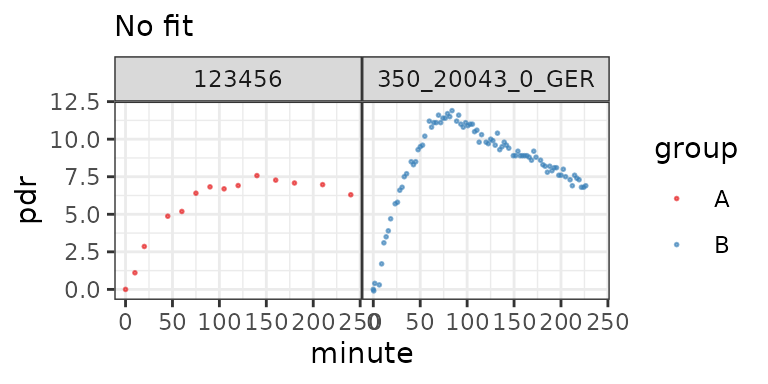
To add new formats, override breathtest_read_function()
and add a new function that returns a structure given by
breathtest_data().
Always pass data through function
cleanup_data()to obtain a data frame that can be fed to one of the fitting functionsnls_fit(),nlme_fit(),null_fit()orbreathteststan::stan_fit().
Automatic grouping
You can add a grouping variable, e.g. for multiple meal types, to compute between group differences of means. Cross-over, randomized or mixed designs (some patients cross-over) are supported.
You must explicitlty state the grouping variable for each single file
as shown below. Without names, it is possible to vectorize,
e.g. read_any_breathtest(c(file1, file2)), but the ‘c()’
operator used on vectors disambiguates the names by appending
numbers.
files1 = c(
group_a = btcore_file("IrisCSV.TXT"), # Use only single file with grouping
group_a = btcore_file("Standard.TXT"),
group_b = btcore_file("350_20043_0_GER.txt")
)
# Alternative syntax using magrittr operator
suppressPackageStartupMessages(library(dplyr))
read_any_breathtest(files1) %>%
cleanup_data() %>%
null_fit() %>%
plot()
Simulated data
Function simulate_breathtest_data() generates sample
data you can use to test different algorithms. Curves with outliers can
be generated by setting student_t_df to values from 2 (very
strong outliers) to 10 (almost gaussian).
set.seed(212)
data = list(meal_a = simulate_breathtest_data(n_records = 3, noise = 2,
student_t_df = 3, missing = 0.3),
meal_b = simulate_breathtest_data(n_records = 4))
data %>%
cleanup_data() %>%
nlme_fit() %>%
plot()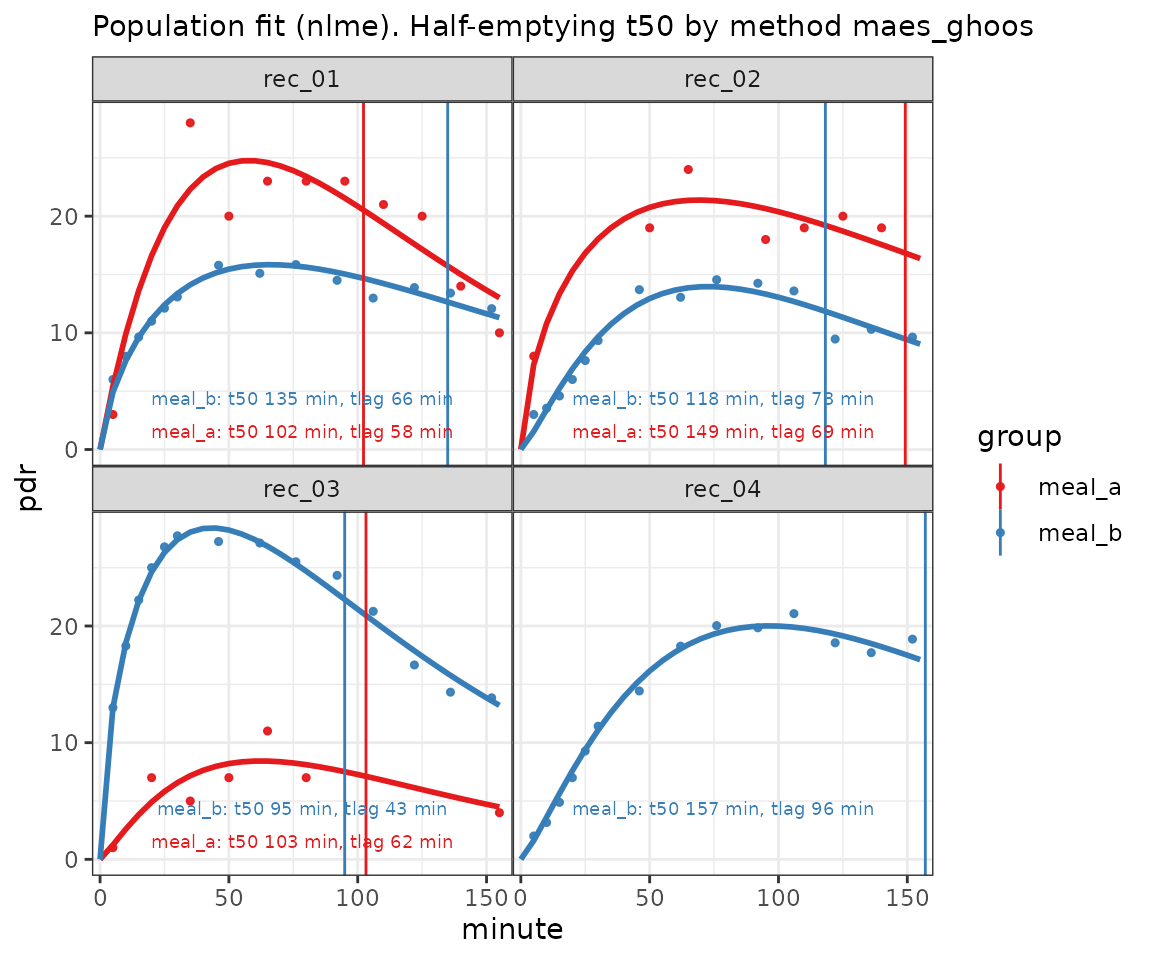
Example of a cross-over design with missing data, outliers and missing record in the red curve.
data$meal_a$record patient_id m k beta t50_maes_ghoos
1 rec_01 38 0.01310 2.41 106
2 rec_02 47 0.00918 1.69 119
3 rec_03 16 0.01039 2.25 128Built-in data sets
Three data sets are included in R format and can be loaded as shown below. All data were provided by the University Hospital of Zürich; details are given in the documentation.
data("usz_13c")
cat("usz_13c has data from", length(unique(usz_13c$patient_id)), "patients with" ,
length(unique(usz_13c$group)), "different meals")usz_13c has data from 163 patients with 4 different meals-
breathtestcore::usz_13cA large data set used to establish reference ranges for healthy volunteers and patients -
breathtestcore::usz_13c_aExotic data, a challenge for fitting algorthms -
breathtestcore::usz_13c_dHas gastric emptying half time from MRI as attribute, and can used to compare recorded data with gold standards; see the example in the documentation.
Generic formats
The easiest way to supply generic formats is from Excel files. The
data formats described in the following are shown as examples in the
workbook
/opt/R/4.5.1/lib/R/library/breathtestcore/extdata/ExcelSamples.xlsx.
Any other tab-separated data set can directly be inserted into the
editor of the breathtestshiny web
app using copy/paste.
How to use the Excel data formats
- Use function
read_breathtest_excel(); this is the only way to select a worksheet different other than first in the workbook by passing parametersheet. All other methods only read the first worksheet. - Use function
read_any_breathtest(). This always reads the first worksheet, but you can combine results from several files, even when they have different formats
Two-column format
When you have only data from one record, you can supply data in a
two-column format as given in sheet 2col of workboot
ExcelSamples.xlsx. The column headers must be `minute,
(bt = read_breathtest_excel(btcore_file("ExcelSamples.xlsx"), "2col"))[[1]]
[38;5;246m# A tibble: 22 × 2
[39m
minute pdr
[3m
[38;5;246m<dbl>
[39m
[23m
[3m
[38;5;246m<dbl>
[39m
[23m
[38;5;250m1
[39m 0.42 0.547
[38;5;250m2
[39m 11.9 1.64
[38;5;250m3
[39m 23.4 3.89
[38;5;250m4
[39m 34.9 6.13
[38;5;246m# ℹ 18 more rows
[39mA list is returned, and its only element is a tibble with two
columns. To create a standardized format for fitting and plotting, pass
it through cleanup_data which adds dummy columns
patient_id (all pat_a), and group
(all A)
(cbt = cleanup_data(bt))
[38;5;246m# A tibble: 22 × 4
[39m
patient_id group minute pdr
[3m
[38;5;246m<chr>
[39m
[23m
[3m
[38;5;246m<chr>
[39m
[23m
[3m
[38;5;246m<dbl>
[39m
[23m
[3m
[38;5;246m<dbl>
[39m
[23m
[38;5;250m1
[39m pat_a A 0.42 0.547
[38;5;250m2
[39m pat_a A 11.9 1.64
[38;5;250m3
[39m pat_a A 23.4 3.89
[38;5;250m4
[39m pat_a A 34.9 6.13
[38;5;246m# ℹ 18 more rows
[39mCompute the fit and plot
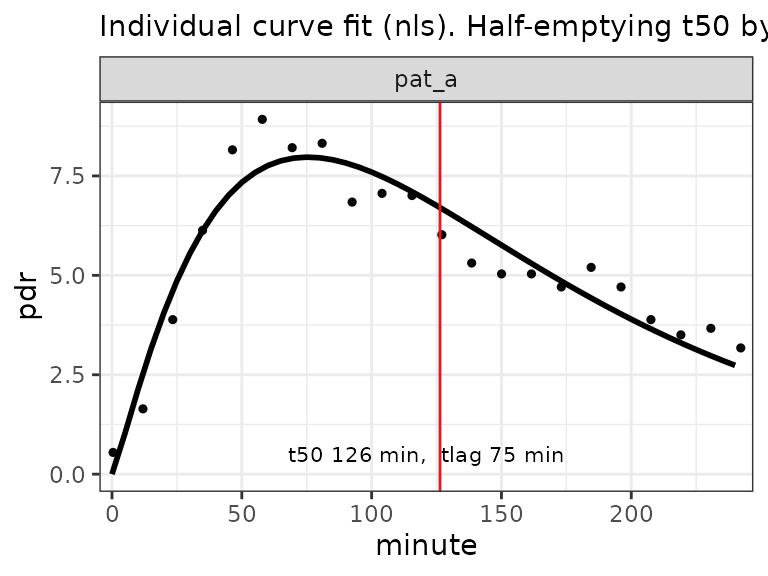
Three-column format
When you have more than one patient, you must add a column
patient_id which may be numeric or a string.
(bt = read_breathtest_excel(btcore_file("ExcelSamples.xlsx"), "3col"))[[1]]
[38;5;246m# A tibble: 43 × 3
[39m
patient_id minute pdr
[3m
[38;5;246m<chr>
[39m
[23m
[3m
[38;5;246m<dbl>
[39m
[23m
[3m
[38;5;246m<dbl>
[39m
[23m
[38;5;250m1
[39m 7951500 0.42 0.547
[38;5;250m2
[39m 7951500 11.9 1.64
[38;5;250m3
[39m 7951500 23.4 3.89
[38;5;250m4
[39m 7951500 34.9 6.13
[38;5;246m# ℹ 39 more rows
[39m
(cbt = cleanup_data(bt))
[38;5;246m# A tibble: 43 × 4
[39m
patient_id group minute pdr
[3m
[38;5;246m<chr>
[39m
[23m
[3m
[38;5;246m<chr>
[39m
[23m
[3m
[38;5;246m<dbl>
[39m
[23m
[3m
[38;5;246m<dbl>
[39m
[23m
[38;5;250m1
[39m 7951500 A 0.42 0.547
[38;5;250m2
[39m 7951500 A 11.9 1.64
[38;5;250m3
[39m 7951500 A 23.4 3.89
[38;5;250m4
[39m 7951500 A 34.9 6.13
[38;5;246m# ℹ 39 more rows
[39mA dummy group ‘A’ is added by cleanup_data(), so that
data are in a standardized format now.
Four-column format
The four-column format with column names
patient_id, group, minute, pdr is the standard format. In
cross-over designs, you can have different groups for one patient.
bt = read_breathtest_excel(btcore_file("ExcelSamples.xlsx"), "4col_2group") %>%
cleanup_data()
kable(sample_frac(bt, 0.08) %>% arrange(patient_id, group), caption = "A sample from a four-column format. See worksheet 4col_2group.")| patient_id | group | minute | pdr |
|---|---|---|---|
| norm_001 | liquid_normal | 105 | 14.0 |
| norm_001 | liquid_normal | 90 | 13.6 |
| norm_002 | solid_normal | 140 | 4.8 |
| norm_003 | liquid_normal | 140 | 8.3 |
| norm_003 | solid_normal | 180 | 3.6 |
| norm_004 | liquid_normal | 40 | 13.4 |
| norm_004 | liquid_normal | 50 | 13.5 |
| norm_004 | liquid_normal | 30 | 10.8 |
| norm_005 | liquid_normal | 180 | 8.9 |
| norm_005 | liquid_normal | 140 | 12.2 |
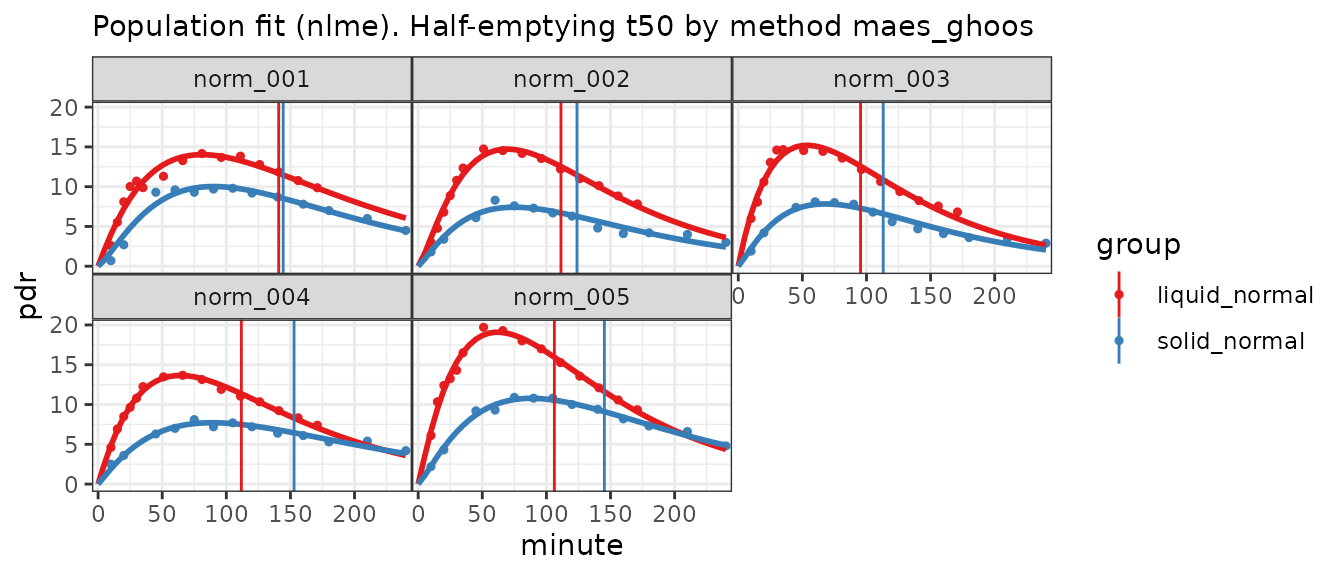
DOB instead of PDF
When you have DOB data (d), you can use dob instead of
pdr as the header of the last column. DOB data will be
automatically converted to PDR with function dob_to_pdr().
Since no body weight and height are given, the defaults of 75kg and 180
cm are assumed.
The half-emptying time and lags do not depend on this assumptions.
Only the parameter m of the fit which normalized area and
amplitude, is affected, and I do not know of a case the m
has been used in clinical practice.
Vendor-specific formats
IRIS-Wagner composite data
The first lines of IrisMulti.TXT
"Testergebnis"
"Nummer","22"
"Datum","12.06.2009"
"Testart"
"Name","Magenentleerung fest"
"Abkürzung","GE FEST"
"Substrat","Natriumoktanoat"Use read_iris() or read_any_breathtest()
:
read_iris(btcore_file("IrisMulti.TXT")) %>%
cleanup_data() %>%
null_fit() %>%
plot()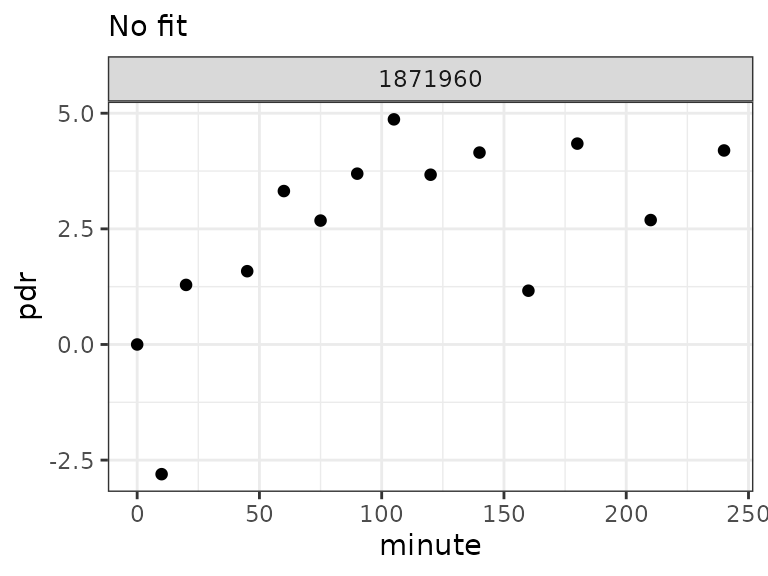
IRIS/Wagner composite file. These data cannot be fitted successfully with the single-curve fit method, therefore only data are shown.
IRIS/Wagner CSV format
Files in this format start like this (lines shortened …)
"Name","Vorname","Test","Identifikation","Testzeit[min]",...
"Einstein","Albert","GE FEST","330240","0","0","-26.32","4.501891E-02", ...
"Einstein","Albert","GE FEST","330240","10","2.02","-24.3","5.617962E-02","2.391013",..
"Einstein","Albert","GE Use read_iris_csv() or
read_any_breathtest() :
read_iris_csv(btcore_file("Standard.TXT")) %>%
cleanup_data() %>%
nls_fit() %>%
plot()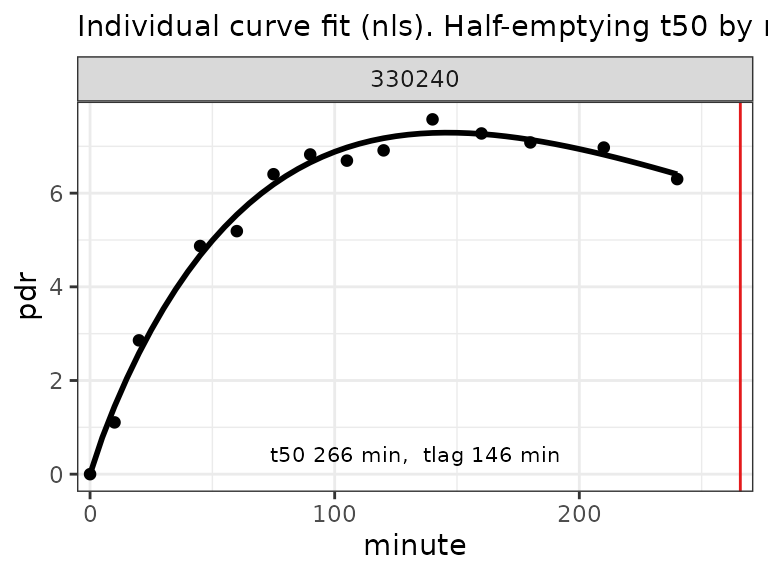
IRIS/Wagner CSV file
BreathID composite format
Files in this format start like this
Test and Patient parameters
Date - 12/11/12
End time - 08:54
Start time - 12:49
Patient # - 0
Patient ID - Franz
Use read_breathid() or
read_any_breathtest():
read_breathid(btcore_file("350_20043_0_GER.txt")) %>%
cleanup_data() %>%
nls_fit() %>%
plot()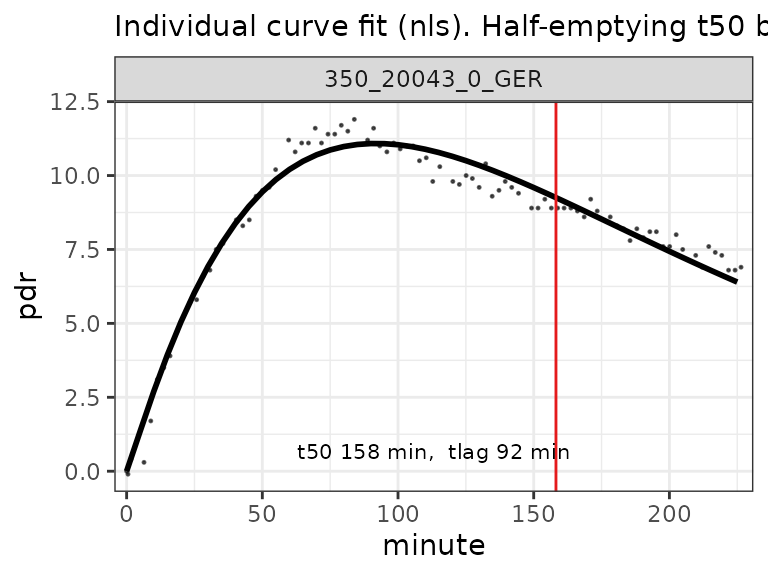
BreathID composite file
BreathID XML format
The more recent XML format from BreathID can contain data from multiple record and starts like this:
<Tests Device="1402">
<Test Number="2">
<ID>TEST123</ID>
<DOB>N/A</DOB>
<StartTime>19Jul2017 11:56</StartTime>
<EndTime>19Jul2017 12:12</EndTime>
<LastResultCode>0</LastResultCode>
<StoppedByUser>true</StoppedByUser>
</Test>
<Test Number="3">
<ID>45689</ID>
<StartTime>19Jul2017 12:22</StartTime>
<EndTime>19Jul2017 12:29</EndTime>
<LastResultCode>0</LastResultCode>Use read_breathid_xml() or
read_any_breathtest():
read_breathid_xml(btcore_file("NewBreathID_multiple.xml")) %>%
cleanup_data() %>%
nls_fit() %>%
plot()
BreathID XML format
Grouping is most useful in a cross-over design to force
within-subject comparisons by functions coef_by_group() and
coef_diff_by_group(); in the above case, the default
grouping above might not be what you required. Replace the group
parameter manually to remove the groups, but do not delete the column
with group = NULL, because the fitting functions requires a
dummy group name.
# Could also use read_any_breathtest()
read_breathid_xml(btcore_file("NewBreathID_multiple.xml")) %>%
cleanup_data() %>%
mutate(
group = "New"
) %>%
nls_fit() %>%
plot()
BreathID XML format with manual grouping.